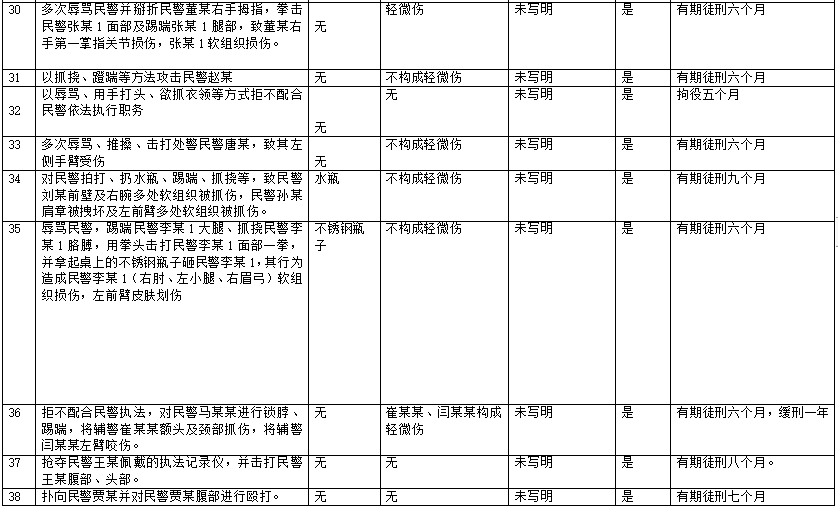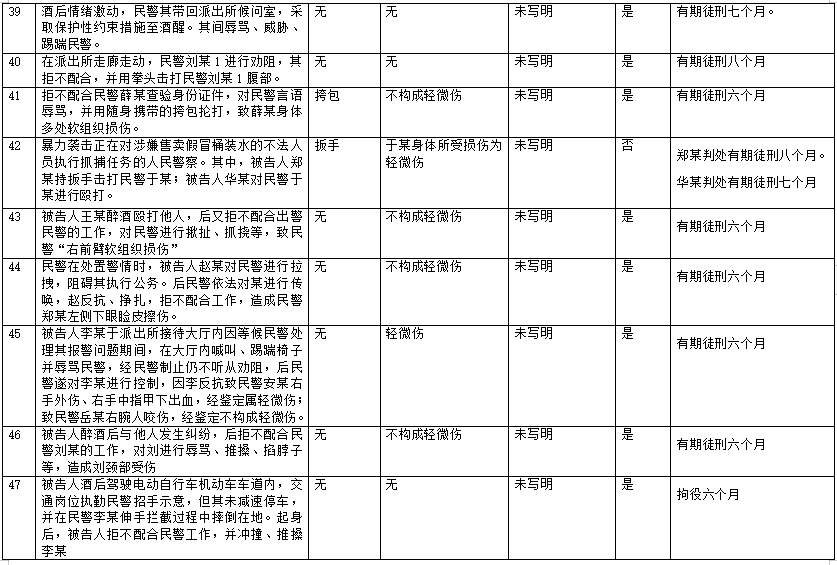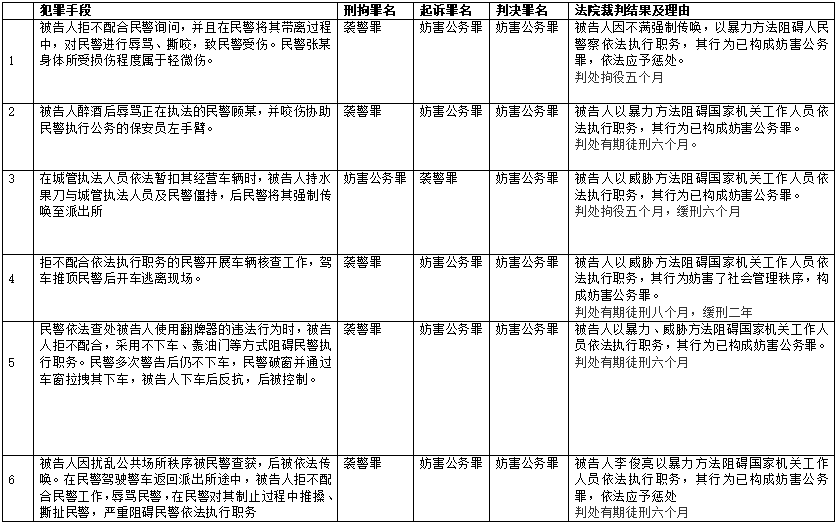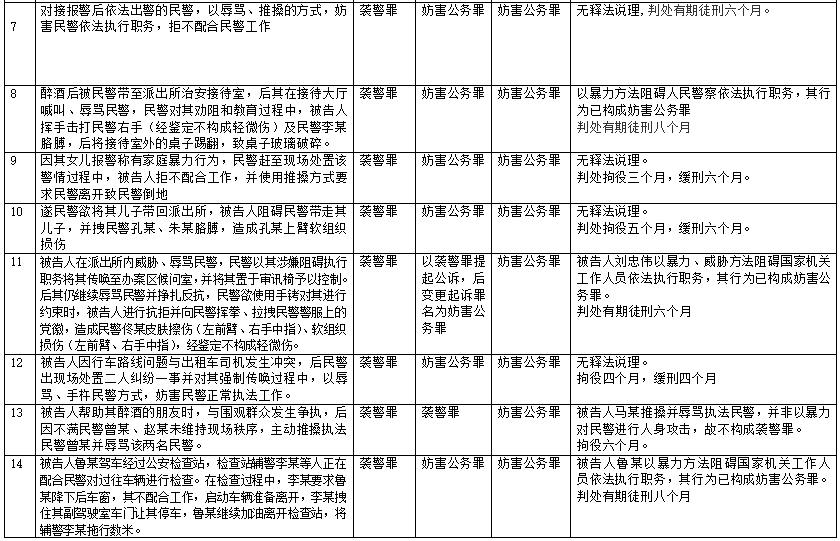Trial Practice of Attacking Police in Beijing
Article 31 of the "Amendment (11) to the Criminal Law of the People's Republic of China" (hereinafter referred to as the "Amendment (11) to the Criminal Law"), implemented on March 1, 2021, stipulates that: "The fifth paragraph of Article 277 of the Criminal Law is amended to read: Anyone who violently attacks a people's police officer who is performing their duties according to law shall be sentenced to fixed-term imprisonment of not more than three years, criminal detention, or public surveillance; anyone who uses guns, controlled knives, or by driving a motor vehicle against him or her, thereby seriously endangering his or her personal safety, shall be sentenced to fixed-term imprisonment of not less than three years but not more than seven years." According to the Supreme People's Court implemented on March 1, 2021 According to the Supplementary Provisions on the Implementation of the Criminal Law of the People's Republic of China on the Determination of Crimes (VII) issued by the Supreme People's Procuratorate, the crimes established in this article are the crime of assaulting a police officer.
The crime of assaulting a police officer is about to be applied for a year. In order to understand the basic patterns and characteristics of this crime in judicial practice, the author collected judgments from the Judicial Documents Network in Beijing and summarized its basic elements in order to have a more comprehensive understanding of the judicial practice of the crime of assaulting a police officer.
Enter three keywords: assault on police, Beijing City, and grassroots courts (retrieved on February 5, 2022), with a total of 105 judgments. After a cursory review of 105 judgments, it was found that 17 judgments identified different charges in the three stages of investigation, prosecution, and trial, mainly the differences between the crime of assaulting a police officer and the crime of obstructing official duties. The author made a special list of these judgments for research. The other 88 judgments are based on a consistent understanding between the public prosecutor and the law. From filing a case to sentencing, they are all crimes of assaulting a police officer. In order to have a sufficient number of samples to ensure the comprehensiveness and accuracy of the study, and to avoid excessive duplication and waste of time, the author decided to select 50 judgments of assaulting police officers as research samples to sort out the current situation of assaulting police officers.
1、 The Basic Characteristics of the Crime of Attacking a Police Officer
According to the main conviction and sentencing elements of the crime of assaulting a police officer, the author can basically have a comprehensive understanding of the crime of assaulting a police officer by selecting six variables: criminal means, whether armed, whether injured, whether to compensate and obtain understanding from the victim, whether to plead guilty to punishment, and the outcome of the judgment. The following table provides basic information about 50 decisions:





After studying the above 50 judgments, it can be confirmed that all crimes of assaulting a police officer occur in the process of the police performing their official duties according to law. One is to arrest a robbery suspect, the other is to deal with illegal vendors with urban management staff, and the other is the process of the police receiving the police and appearing to handle civil disputes. The vast majority of defendants in the crime of assaulting a police officer are also parties to disputes handled by the police. Some of the reasons for assaulting a police officer are refusal to be taken away, drunkenness, dissatisfaction with the police's handling or results, and arrogance.
From the perspective of criminal means, the main violent means of assaulting a police officer include abuse, beating, kicking, pushing, grasping, and biting. "It is a common form of violence, but compared to the degree of violence in the crime of intentional injury, it is relatively mild.". Professor Zhang Mingkai believes in "The Basic Issues of the Crime of Attacking a Police Officer" that violent attacks in the crime of attacking a police officer are only limited to active physical violence (direct violence) against the police officer, and must have a sudden nature, which refers to the direct physical violence committed by the police officer against the police officer when the police are not on guard against the perpetrator. It can only be manifested as actively attacking the person of the police, not including passive resistance. For example, when multiple police officers seize the perpetrator's hands and feet to detain him or her and lift him or her onto a police car, the perpetrator swings his or her hands and feet in order to break free. Even if direct violence is formed against the police's body, this simple negative "resistance" cannot be recognized as a crime of assaulting the police. According to Professor Zhang Mingkai's definition of violent attacks, it is clear that some of the defendant's actions in the 50 judgments do not belong to violent attacks, but rather push, kick, and bite when escaping or resisting police control. For example, when the police restrained the drunken defendant, the defendant broke free and kicked the police, while others refused to be taken back to the police station, resisting the police's control and punching and kicking.
The vast majority of the accused attacked the police unarmed, with only a few holding lethal weapons. When arresting a robbery suspect, the suspect confronts with a knife. In addition, it is useful to attack the police with umbrellas, handbags, or bottles that you have picked up, while others are unarmed. This indicates that the crime of assaulting a police officer occurs suddenly, without premeditation or preparation of a murder weapon.
From the perspective of the degree of injury to the police, there were 13 judgments in which the degree of physical injury to the police was minor, accounting for 26%, while the others did not constitute minor injuries or were not specified. "None of the 50 judgments constitute minor injuries to the police, indicating that the overall level of violence in the crime of assaulting police officers is relatively low, and there is no serious personal injury to the police.". The author analyzes and believes that: First, the defendants of the crime of assaulting a police officer lose control of their emotions in the face of conflicts and disputes, their words and actions are inappropriate, and they cannot exercise rational restraint. Although they engage in abusive behavior, pushing, and beating, after all, they have no hatred with the police, and the level of violence is moderate; Secondly, the police have the ability to respond and control, and can quickly control minor acts of violence against the accused to avoid causing more serious harm.
Did the police officers who were attacked by violence receive compensation and express understanding from the defendant? According to statistics, only four judgments have indicated compensation and understanding, while other judgments have not mentioned it. The crime of assaulting a police officer protects dual legal interests, both the normal order of state official activities and the personal rights and interests of personnel performing their duties. The law does not prohibit public servants from disposing of their personal legal interests infringed upon when performing their duties according to law, such as accepting an apology from the infringer or compensating for losses. In judicial practice, if the defendant wants to obtain a lighter punishment, compensating the police and obtaining their understanding is an important act to alleviate social harm, and is also the main manifestation of pleading guilty to punishment. There is less mention of it in the judgment, and I wonder if it is not, or do I think it is unnecessary to mention it.
Regarding the admission of guilt and punishment, only three defendants, accounting for 6%, did not plead guilty to punishment. The rate of confession and punishment for assaulting police officers reached 94%, higher than the average rate of confession and punishment for all crimes. The reason for this is that the author believes that the crime of assaulting a police officer occurs during the process of police enforcement, with at least two police officers or auxiliary police officers present and recorded by the law enforcement apparatus. The facts are relatively clear and the evidence is sufficient, making it almost impossible to plead not guilty, so the defendants ultimately choose to plead guilty to a lighter punishment.
On the sentencing of the crime of assaulting a police officer. Of the 50 judgments, 10 defendants were sentenced to suspended sentences, accounting for 20%. There are 15 sentences for criminal detention (including probation), and the rest are fixed-term imprisonment (including probation). The heaviest sentence is one year and two months of imprisonment, and the lightest is three months of detention. The highest frequency of sentencing is six months' imprisonment, with a total of 22 sentences, accounting for 44%. Among the 13 judgments for police officers with minor injuries, the lightest sentence is four months of detention, four months of probation, and the heaviest sentence is eight months of fixed-term imprisonment.
2、 Discrimination between Crime of the Obstructing Public Service and Crime of the Attacking Police



The 17 judgments in the table all convicted and sentenced the defendant for the crime of impairing official duties. From the perspective of the applicable charges at various stages of litigation, 16 of the 17 cases mentioned above took coercive measures against the defendant for the crime of assaulting a police officer during the investigation stage, and 13 were prosecuted for the crime of obstructing official duties. It is clear that the position of the procuratorate and the court on the determination of charges is relatively consistent, but there is a significant difference between them and the investigation organ.
The main difference between the crime of impairing official duties and the crime of assaulting a police officer lies in whether the defendant violently assaults the police officer performing his duties. According to the criminal facts of the crime of impairing official duties identified in 17 judgments, the criminal means can be divided into two categories: 1. No physical violence against the police. Such as confronting with a knife, blowing the gas pedal, pushing the car to the top, and bringing the police down by motorcycle. In this type of behavior, the accused did not engage in direct physical violence against the police, but engaged in passive confrontation. 2. During the process of resisting police law enforcement, there are negative and violent behaviors such as abuse and pushing. For example, the defendant, Zhao, caused trouble at the south gate of the community after drinking alcohol and refused to cooperate with the police in performing their duties according to law by abusing others, using their hands to head off, or trying to grab their collars. In this case, both the investigation and public prosecution authorities believe that Zhao constituted a crime of assaulting a police officer, but the court believes that although the defendant Zhao used his hand to hit the police officer on the head and attempted to grasp the police officer's collar, he only hit the police officer's hat, causing no harmful consequences to the police officer. His behavior has not yet reached the level of violence and harmful consequences of the crime of assaulting a police officer, he should be investigated for criminal responsibility as a crime of interfering with official duties. Another example is the defendant, Ma, who had a dispute with the crowd while helping a drunken friend. Later, he was dissatisfied that the police officers, Zeng and Zhao, had not maintained order on the scene, and actively pushed and pushed the law enforcement police officers, Zeng, and abused the two police officers. The prosecution authority also initiated a public prosecution for the crime of assaulting a police officer, but the court held that the defendant, Ma, pushed and abused the law enforcement police, not physically assaulting the police with violence, so it did not constitute the crime of assaulting a police officer. "In all cases where the indicted charges and the convicted charges are inconsistent, the judgment has provided interpretation reasoning, while in other cases, if the indicted charges and the convicted charges are consistent, no interpretation reasoning has been provided.".
However, comparing the 17 criminal means of impairing official duties with the 50 criminal means of assaulting police officers mentioned above, we can find many similarities and even similarities. For example, during the execution of police duties, there are negative and violent behaviors such as pushing and kicking during the enforcement process of resisting the police. "The purpose of every actor is not to directly attack the police, but to resist the stress response of mandatory measures such as police arrest.". It can be seen that the boundary between the crime of impairing official duties and the crime of assaulting a police officer is still unclear, and the same behavior may have different results in different regions and different judges.
From the perspective of the degree of harm caused by criminal results, 2 of the 17 judgments were slightly injured, accounting for 11%. The probability of minor injuries in the crime of impairing official duties is significantly lower than that in the crime of assaulting a police officer, indicating a lower level of violence. Accordingly, in terms of sentencing, five of the defendants in the 17 judgments were sentenced to suspended sentences. The probation application rate is 29%, higher than the probation application rate for the crime of assaulting a police officer. In addition to the cases where probation is applicable, the sentencing of other cases is mostly around six months of fixed-term imprisonment, which is not significantly lighter than the degree of reprieve for the crime of assaulting a police officer.
In summary, since the application of the crime of assaulting a police officer, it has played a role in maintaining the order of national official activities and the personal safety of the police, and the sentencing in Beijing is also basically balanced. However, the main problem is that the application of the crime of impairing official duties intersects and overlaps, and the difference between the two is unclear. It is necessary to further clarify the boundaries between theory and practice and apply them accurately.
Related recommendations
- Tax lawyers review the draft of the revised Tax Collection and Administration Law for soliciting opinions
- New Measures for Punishing "Dishonesty" by the Supreme People's Court at the Two Sessions in 2025 (Part 3): "Height Limit" Single Release Mechanism
- New Measures for Punishing "Dishonesty" by the Supreme People's Court at the Two Sessions in 2025 (Part 2): Grace Period System
- Interpretation of the Management Measures for Compliance Audit of Personal Information Protection - Feeling the Rhythm and Rhythm of Regulatory Flow



